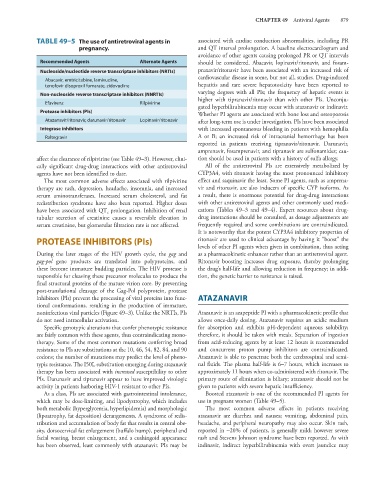Page 893 - Basic _ Clinical Pharmacology ( PDFDrive )
P. 893
CHAPTER 49 Antiviral Agents 879
TABLE 49–5 The use of antiretroviral agents in associated with cardiac conduction abnormalities, including PR
pregnancy. and QT interval prolongation. A baseline electrocardiogram and
avoidance of other agents causing prolonged PR or QT intervals
Recommended Agents Alternate Agents should be considered. Abacavir, lopinavir/ritonavir, and fosam-
Nucleoside/nucleotide reverse transcriptase inhibitors (NRTIs) prenavir/ritonavir have been associated with an increased risk of
cardiovascular disease in some, but not all, studies. Drug-induced
Abacavir, emtricitabine, lamivudine,
tenofovir disoproxil fumarate, zidovudine hepatitis and rare severe hepatotoxicity have been reported to
varying degrees with all PIs; the frequency of hepatic events is
Non-nucleoside reverse transcriptase inhibitors (NNRTIs)
higher with tipranavir/ritonavir than with other PIs. Unconju-
Efavirenz Rilpivirine
gated hyperbilirubinemia may occur with atazanavir or indinavir.
Protease inhibitors (PIs)
Whether PI agents are associated with bone loss and osteoporosis
Atazanavir/ritonavir, darunavir/ritonavir Lopinavir/ritonavir after long-term use is under investigation. PIs have been associated
Integrase inhibitors with increased spontaneous bleeding in patients with hemophilia
Raltegravir A or B; an increased risk of intracranial hemorrhage has been
reported in patients receiving tipranavir/ritonavir. Darunavir,
amprenavir, fosamprenavir, and tipranavir are sulfonamides; cau-
affect the clearance of rilpivirine (see Table 49–3). However, clini- tion should be used in patients with a history of sulfa allergy.
cally significant drug-drug interactions with other antiretroviral All of the antiretroviral PIs are extensively metabolized by
agents have not been identified to date. CYP3A4, with ritonavir having the most pronounced inhibitory
The most common adverse effects associated with rilpivirine effect and saquinavir the least. Some PI agents, such as amprena-
therapy are rash, depression, headache, insomnia, and increased vir and ritonavir, are also inducers of specific CYP isoforms. As
serum aminotransferases. Increased serum cholesterol, and fat a result, there is enormous potential for drug-drug interactions
redistribution syndrome have also been reported. Higher doses with other antiretroviral agents and other commonly used medi-
have been associated with QT prolongation. Inhibition of renal cations (Tables 49–3 and 49–4). Expert resources about drug-
c
tubular secretion of creatinine causes a reversible elevation in drug interactions should be consulted, as dosage adjustments are
serum creatinine, but glomerular filtration rate is not affected. frequently required and some combinations are contraindicated.
It is noteworthy that the potent CYP3A4 inhibitory properties of
PROTEASE INHIBITORS (PIs) ritonavir are used to clinical advantage by having it “boost” the
levels of other PI agents when given in combination, thus acting
During the later stages of the HIV growth cycle, the gag and as a pharmacokinetic enhancer rather than an antiretroviral agent.
gag-pol gene products are translated into polyproteins, and Ritonavir boosting increases drug exposure, thereby prolonging
these become immature budding particles. The HIV protease is the drug’s half-life and allowing reduction in frequency; in addi-
responsible for cleaving these precursor molecules to produce the tion, the genetic barrier to resistance is raised.
final structural proteins of the mature virion core. By preventing
post-translational cleavage of the Gag-Pol polyprotein, protease
inhibitors (PIs) prevent the processing of viral proteins into func- ATAZANAVIR
tional conformations, resulting in the production of immature,
noninfectious viral particles (Figure 49–3). Unlike the NRTIs, PIs Atazanavir is an azapeptide PI with a pharmacokinetic profile that
do not need intracellular activation. allows once-daily dosing. Atazanavir requires an acidic medium
Specific genotypic alterations that confer phenotypic resistance for absorption and exhibits pH-dependent aqueous solubility;
are fairly common with these agents, thus contraindicating mono- therefore, it should be taken with meals. Separation of ingestion
therapy. Some of the most common mutations conferring broad from acid-reducing agents by at least 12 hours is recommended
resistance to PIs are substitutions at the 10, 46, 54, 82, 84, and 90 and concurrent proton pump inhibitors are contraindicated.
codons; the number of mutations may predict the level of pheno- Atazanavir is able to penetrate both the cerebrospinal and semi-
typic resistance. The I50L substitution emerging during atazanavir nal fluids. The plasma half-life is 6–7 hours, which increases to
therapy has been associated with increased susceptibility to other approximately 11 hours when co-administered with ritonavir. The
PIs. Darunavir and tipranavir appear to have improved virologic primary route of elimination is biliary; atazanavir should not be
activity in patients harboring HIV-1 resistant to other PIs. given to patients with severe hepatic insufficiency.
As a class, PIs are associated with gastrointestinal intolerance, Boosted atazanavir is one of the recommended PI agents for
which may be dose-limiting, and lipodystrophy, which includes use in pregnant women (Table 49–5).
both metabolic (hyperglycemia, hyperlipidemia) and morphologic The most common adverse effects in patients receiving
(lipoatrophy, fat deposition) derangements. A syndrome of redis- atazanavir are diarrhea and nausea; vomiting, abdominal pain,
tribution and accumulation of body fat that results in central obe- headache, and peripheral neuropathy may also occur. Skin rash,
sity, dorsocervical fat enlargement (buffalo hump), peripheral and reported in ~20% of patients, is generally mild; however severe
facial wasting, breast enlargement, and a cushingoid appearance rash and Stevens Johnson syndrome have been reported. As with
has been observed, least commonly with atazanavir. PIs may be indinavir, indirect hyperbilirubinemia with overt jaundice may

